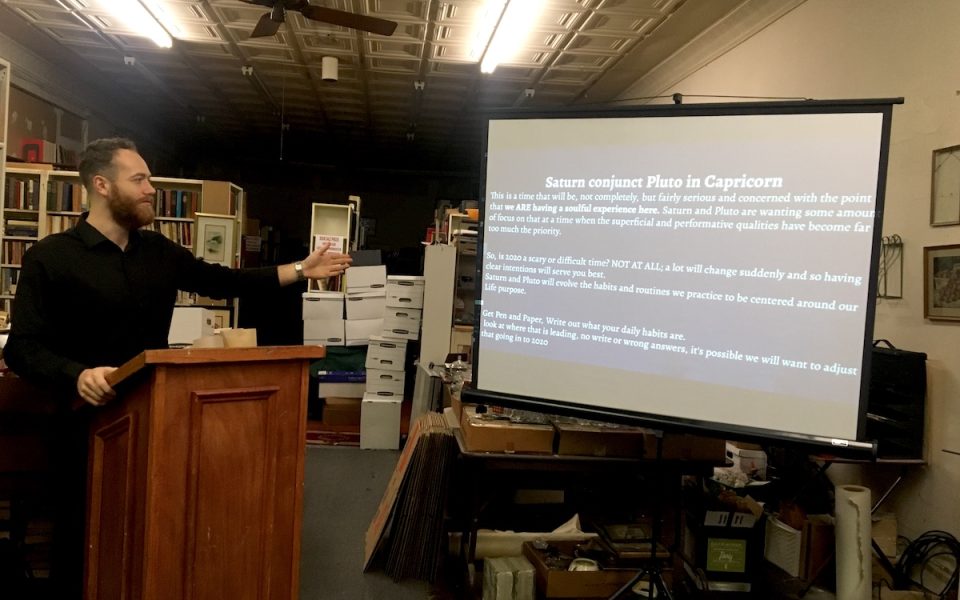It only happens once every 35 years.
Pluto and Saturn, due to their distance from the sun and their long, slow orbits, rarely draw near in astrological maps of the sky. Yet, starting on Sunday, they do so for the first time since the 1980s.
The event is called a conjunction, which describes a meeting of two planets in the same area on a 12-section map. It’s like an intersection of two interstellar roads. The map itself, with one section for each zodiac sign, helps astrologers like Luke Baker chart movements of the solar system, from our perspective on Earth. Over a rainy weekend, he enters Terra Blue in Greensboro to lay out his research, describing how the patterns in space during 2020 could affect the people on our own planet, according to astrology.
“My whole goal with astrology,” Baker says, “is that it’s practical.”
A small crowd sits close to the projector, as Baker begins by pointing out what shifts during each month of the new year, and what each movement symbolizes. Baker speaks of the planets like they have a personality, and each time they pass — or oppose — one another sounds more like an interaction.
Though divining using the stars and planets has been around for centuries, the practice has found an uptick in recent decades, especially amongst millennials and Gen Z, but in Baker’s class, people of all ages gather for his insight.
Baker sees astrology as combining logic with emotions. His clients find that the practice often helps to explain what habits and patterns they fall into, and find more effective self-help methods.
“The goal really truly is that you know yourself more,” Baker says, “know yourself better.”
It goes a lot deeper than horoscopes.
The process involves a lot of arithmetic and geometry, as astrologers aim to chart what the solar system looks like at particular moments, and where each planet or celestial body ends up in the 12-part map. Terms like conjunction, retrograde and opposition all come to describe how a planet moves, or what angle one planet forms with another. Baker explains that with enough math, what the night sky looks like on any day, whether its past, present or future, can be determined.
“Geometry is the biggest part of what I do, actually,” Baker says.
Baker explains the impact of these calculations with metaphors, each planet ascribed a certain influence on a topic. He begins where the planets start out in 2020, and moves through the first major shifts. As Saturn and Pluto near one another, he explains, the two planets will meet in the section of the map that represents Capricorn. Baker translates this as a time of focusing on personal priorities and setting new paths.
He touches on how each planet moves month-by-month, stopping to explain how Mars can bring energy and how Venus implores people to reflect on what they love to do. He mentions a trio of Mercury retrogrades happening in February, June and October. Baker emphasizes that, despite social media portrayals and memes about it, the retrograde does not mean bad luck, but in astrology represents reflection.
Sarah McDavid, owner of Terra Blue, sees reflection as a draw for many people who use astrology. Many guests look to the practice to ask questions, rather than finding answers.
“It’s helping us approach with our hearts, and our heads,” she explains.
One guest, found astrology useful as a method of guidance. After meeting Baker, she began to look more seriously at astrology. Like many others, she said the practice helped to encourage self-exploration.
“It helps ask the right questions,” she said.
As Baker approaches the end of his calendar, he stops to talk about November. He explains how Jupiter joins Saturn and Pluto in Capricorn, a rare moment in astrology that symbolizes taking stock of our past, present and future. Because of their slow orbits, Jupiter, Saturn and Pluto only meet once every few hundred years.
“It’s incredible we’re all here for it,” Baker tells his class.
A woman in the front row raises her hand and asks how the conjunction affects the 2020 election. Baker describes the patterns that could play out, with other influences coming from more signs, like Chiron in Aries. Yet, as with everything else in his practice, Baker steers away from catastrophizing or divining an exact scenario. Instead, he speaks to the power of individual choice.
“We all have free will,” Baker says.
Join the First Amendment Society, a membership that goes directly to funding TCB‘s newsroom.
We believe that reporting can save the world.
The TCB First Amendment Society recognizes the vital role of a free, unfettered press with a bundling of local experiences designed to build community, and unique engagements with our newsroom that will help you understand, and shape, local journalism’s critical role in uplifting the people in our cities.
All revenue goes directly into the newsroom as reporters’ salaries and freelance commissions.


Leave a Reply